Antec P280 Review: When Enthusiasts Are Engineers
by Dustin Sklavos on November 15, 2011 10:20 AM EST- Posted in
- Cases/Cooling/PSUs
- Antec
- P280
Noise and Thermal Testing, Stock
Despite being very enthusiastic about the design of the Antec P280, I had real concerns about performance in practice. I'm just not a fan of negative pressure designs; historically I've seen positive pressure cases produce better thermal results. Antec's reps even asked me about my experiences there, but thankfully the P280 can be configured that way and then some. I also don't like the two exhaust fans in the top; I've never liked top exhaust fans in cases, as it's always seemed like a great way for noise to leak out. So suffice to say, I entered the actual testing of the P280 with some trepidation.
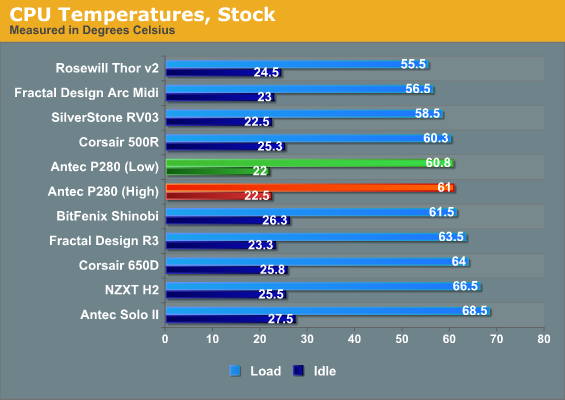
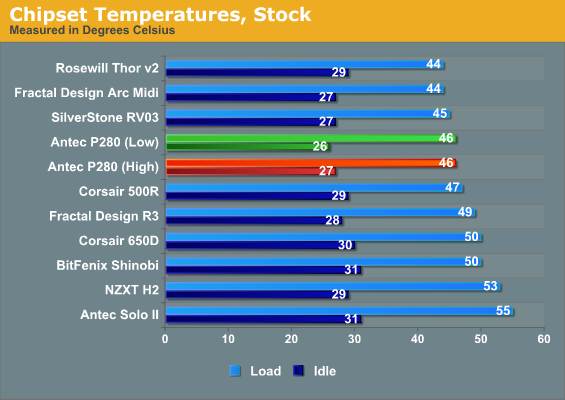
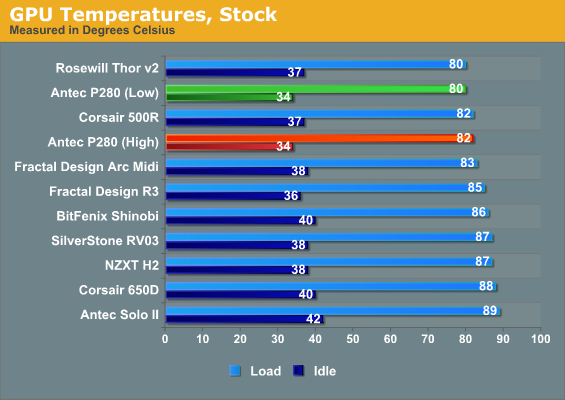
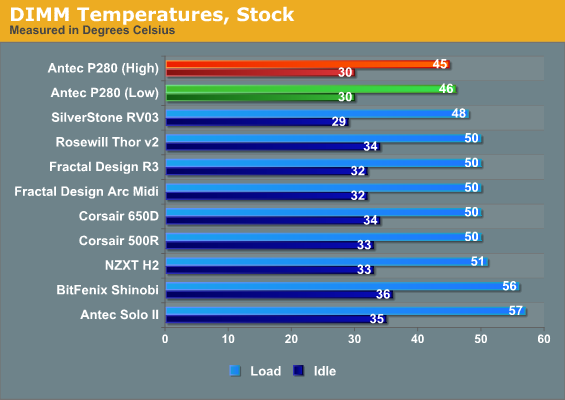

Performance for the P280 is for the most part middle-of-the-road. I think its biggest competitor is probably the up and coming Fractal Design Define R3. What's worth noting is the very minimal impact running the fans at low speeds seems to have had on the enclosure's performance.
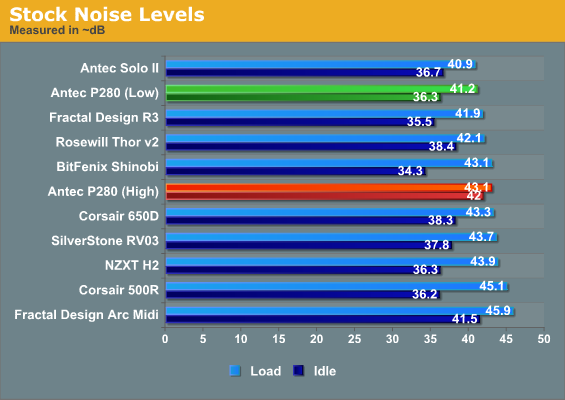
Turning down those fans results in one of the quietest cases we've tested under load, though the results are within the margin of error compared to Fractal Design's Define R3. When we let them ramp up, though, no amount of sound dampening can really save the P280. Thankfully running them at low barely affects thermals, and as a result we get decent performance from a quiet case. So far Antec is on the right track.










164 Comments
View All Comments
tzhu07 - Tuesday, November 15, 2011 - link
I agree. I would only buy full ATX if I was going Crossfire or SLI. Since I don't, microATX covers everything I need.kmmatney - Tuesday, November 15, 2011 - link
it's still nice to have a large case, even if you don't have any expansion cards. I have a P-183 just for low noise. It can easily passively cool my HD4890, and I even have a few of the internal fans turned off. If you want a real quiet (but high performance) system, it easier to do with a full ATX system. The room has to be dead quiet to hear any noise from my system.Zoomer - Tuesday, November 15, 2011 - link
I have a microATX board, and thought it was enough. I thought wrong. Between leaving a slot (preferably two) open next to the gfx card, and a sound card, there's only 1 other slot left. This is frequently slot 0, or right between the gfx and cpu. Non optimal.My next buy would be a ATX board. To be honest, I think the best place for the GPU is the very last slot, so that there's plenty of space for the oversized cooler and some clearance, while not blocking any other slots.
Sound card
TV Tuner card (for kicks)
SATA / HW Raid Card or two. This case support 8 storage drives + optical drives. Your recent Intel chipset doesn't.
Additional nic cards
Serial/Parallel card for tinkering with microcontrollers (Thanks Intel)
Extra Firewire, USB
danjw - Tuesday, November 15, 2011 - link
Not so much. There are X79 boards that are coming with 8 memory slots. You aren't fitting that on a Micro ATX case. It looks like they may be working on a mini P183, that should satisfy you.rum - Thursday, November 17, 2011 - link
Not really, especially when it comes to cable management and the such. A bigger case allows you more room to put cables in their place, and when it comes time to upgrading components, you don't have to worry if your case is "big enough" to accomodate that new extra long video card.Not saying this is the right size for everyone, but not everyone has small hands and dainty fingers that makes working with a small case easy.
kevith - Tuesday, November 15, 2011 - link
I'm almost sure, that if you added two front intake fans, the case would be very much cooler. It's only fair to review the case out of the box, but two additional fans is a relatively small cost. In my Antec Sonata 3 that made a very big difference.In a Zalman 100 GS I had, I reversed the two top fans to intake fans instead, and turned over my Arctic Freezer 90 degrees so the CPU fan was blowing downwards. That took 4-5 degrees off overall.
I think the possibilities for different configs makes this a better choice than the Fractal.
And I think it was a good idea with a comparison to the 182/183 as well.
MrSpadge - Tuesday, November 15, 2011 - link
I also wonder why they used 120 mm fans on top. With a case this wide they could have gone for at least 140 mm, maybe even larger.MrS
Mumrik - Tuesday, November 15, 2011 - link
6x 3.5" internally just still doesn't cut it for me. Especially on a case of this size. I'd rather lose one of the 3x 5.25" and get at least 8x 3.5"rrohbeck - Wednesday, November 16, 2011 - link
Define XL FTW: 10x 3.5". I just built with one.Similar looks, design and price but bigger and better features.
emgarf - Tuesday, November 15, 2011 - link
Congrats on an informative review, although it unfortunately doesn't help those of us using a P182/183 decide whether the P280 is acceptably quiet in comparison. It does certainly seem more convenient to work with.